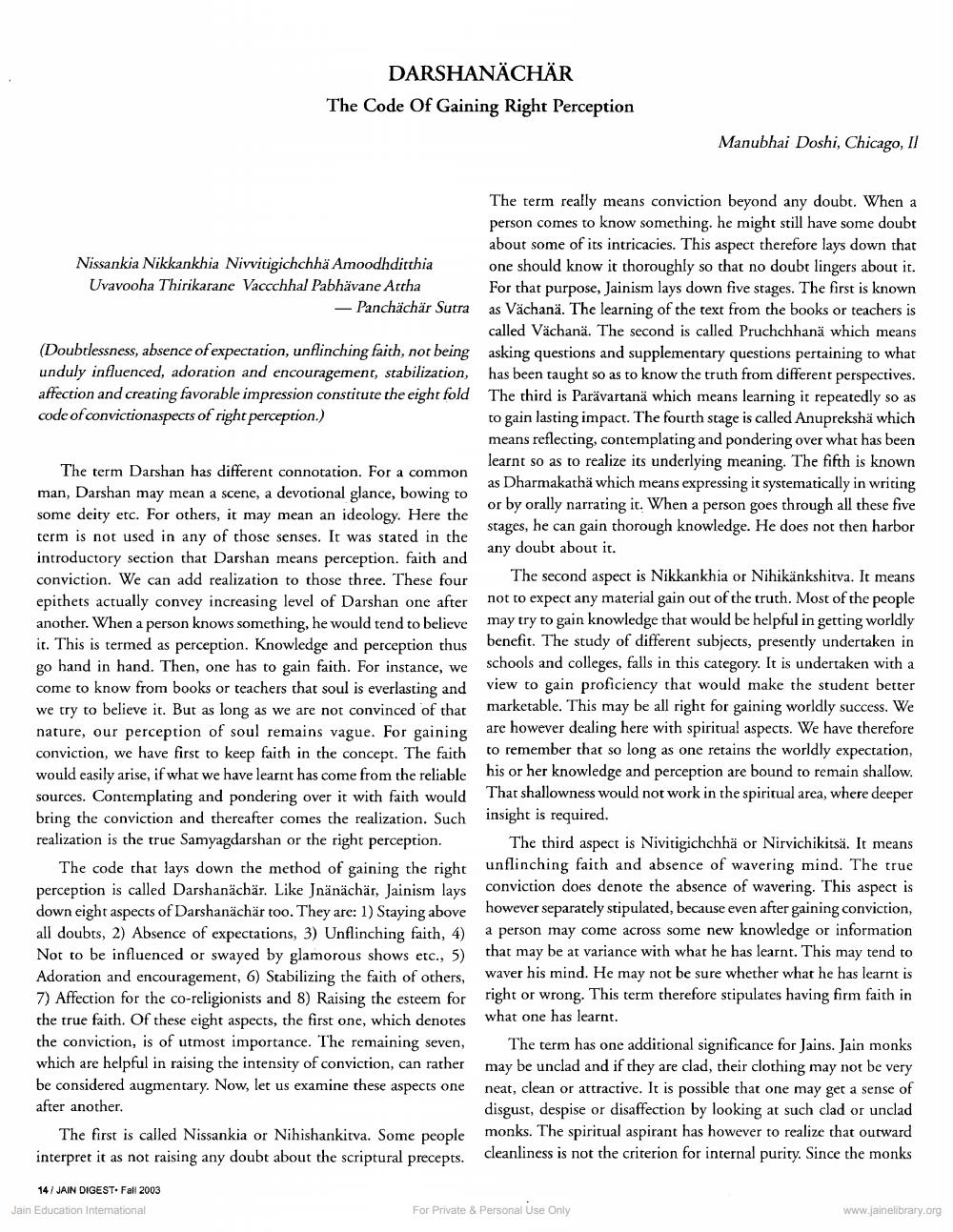________________
DARSHANÄCHÄR
The Code Of Gaining Right Perception
Nissankia Nikkankhia Nivvitigichchhä Amoodhditthia Uvavooha Thirikarane Vaccchhal Pabhävane Attha - Panchächär Sutra
(Doubtlessness, absence of expectation, unflinching faith, not being unduly influenced, adoration and encouragement, stabilization, affection and creating favorable impression constitute the eight fold code of convictionaspects of right perception.)
The term Darshan has different connotation. For a common
man, Darshan may mean a scene, a devotional glance, bowing to some deity etc. For others, it may mean an ideology. Here the term is not used in any of those senses. It was stated in the introductory section that Darshan means perception. faith and conviction. We can add realization to those three. These four epithets actually convey increasing level of Darshan one after another. When a person knows something, he would tend to believe it. This is termed as perception. Knowledge and perception thus go hand in hand. Then, one has to gain faith. For instance, we come to know from books or teachers that soul is everlasting and we try to believe it. But as long as we are not convinced of that nature, our perception of soul remains vague. For gaining conviction, we have first to keep faith in the concept. The faith would easily arise, if what we have learnt has come from the reliable sources. Contemplating and pondering over it with faith would bring the conviction and thereafter comes the realization. Such realization is the true Samyagdarshan or the right perception.
The code that lays down the method of gaining the right perception is called Darshanächär. Like Jnänächär, Jainism lays down eight aspects of Darshanächär too. They are: 1) Staying above all doubts, 2) Absence of expectations, 3) Unflinching faith, 4) Not to be influenced or swayed by glamorous shows etc., 5) Adoration and encouragement, 6) Stabilizing the faith of others, 7) Affection for the co-religionists and 8) Raising the esteem for the true faith. Of these eight aspects, the first one, which denotes the conviction, is of utmost importance. The remaining seven, which are helpful in raising the intensity of conviction, can rather be considered augmentary. Now, let us examine these aspects one
after another.
The first is called Nissankia or Nihishankitva. Some people interpret it as not raising any doubt about the scriptural precepts.
14/JAIN DIGEST⚫ Fall 2003 Jain Education Intemational
Manubhai Doshi, Chicago, Il
The term really means conviction beyond any doubt. When a person comes to know something. he might still have some doubt about some of its intricacies. This aspect therefore lays down that one should know it thoroughly so that no doubt lingers about it. For that purpose, Jainism lays down five stages. The first is known as Vächanä. The learning of the text from the books or teachers is called Vächanä. The second is called Pruchchhanä which means asking questions and supplementary questions pertaining to what has been taught so as to know the truth from different perspectives. The third is Parävartanä which means learning it repeatedly so as to gain lasting impact. The fourth stage is called Anuprekshä which means reflecting, contemplating and pondering over what has been learnt so as to realize its underlying meaning. The fifth is known
as Dharmakatha which means expressing it systematically in writing or by orally narrating it. When a person goes through all these five stages, he can gain thorough knowledge. He does not then harbor any doubt about it.
The second aspect is Nikkankhia or Nihikänkshitva. It means not to expect any material gain out of the truth. Most of the people may try to gain knowledge that would be helpful in getting worldly benefit. The study of different subjects, presently undertaken in schools and colleges, falls in this category. It is undertaken with a view to gain proficiency that would make the student better marketable. This may be all right for gaining worldly success. We are however dealing here with spiritual aspects. We have therefore to remember that so long as one retains the worldly expectation, his or her knowledge and perception are bound to remain shallow. That shallowness would not work in the spiritual area, where deeper insight is required.
The third aspect is Nivitigichchhä or Nirvichikitsä. It means unflinching faith and absence of wavering mind. The true conviction does denote the absence of wavering. This aspect is however separately stipulated, because even after gaining conviction, a person may come across some new knowledge or information that may be at variance with what he has learnt. This may tend to waver his mind. He may not be sure whether what he has learnt is right or wrong. This term therefore stipulates having firm faith in what one has learnt.
The term has one additional significance for Jains. Jain monks may be unclad and if they are clad, their clothing may not be very neat, clean or attractive. It is possible that one may get a sense of disgust, despise or disaffection by looking at such clad or unclad monks. The spiritual aspirant has however to realize that outward cleanliness is not the criterion for internal purity. Since the monks
For Private & Personal Use Only
www.jainelibrary.org




